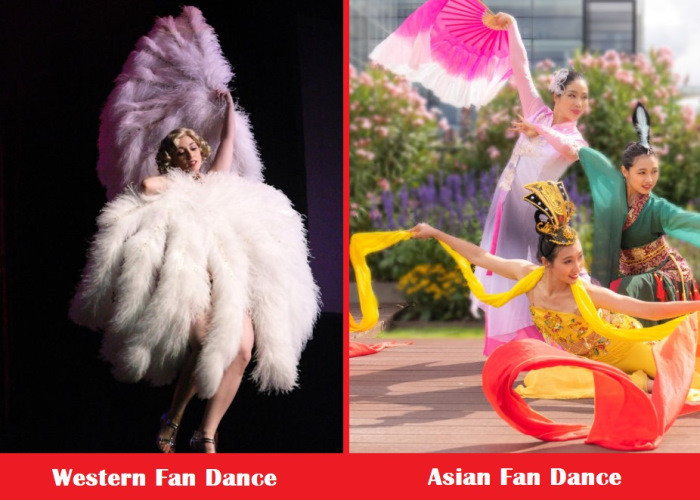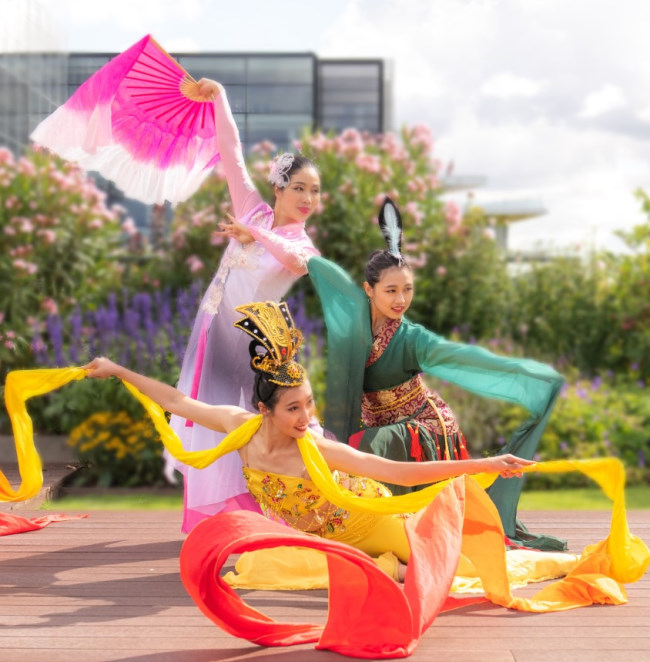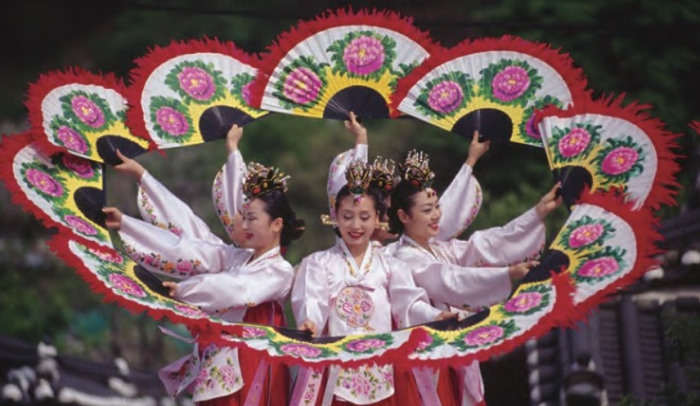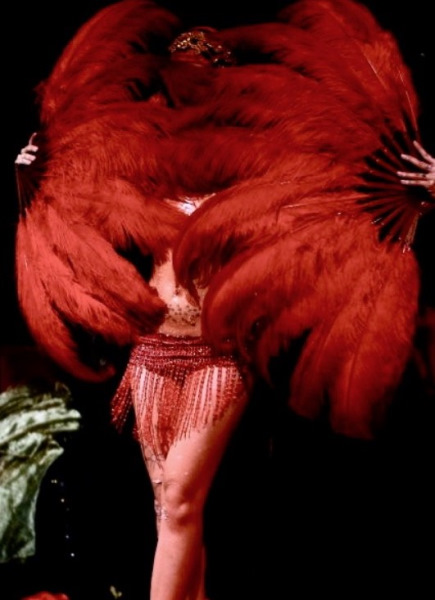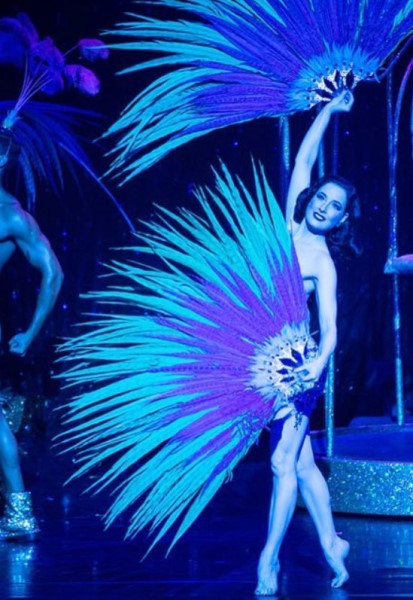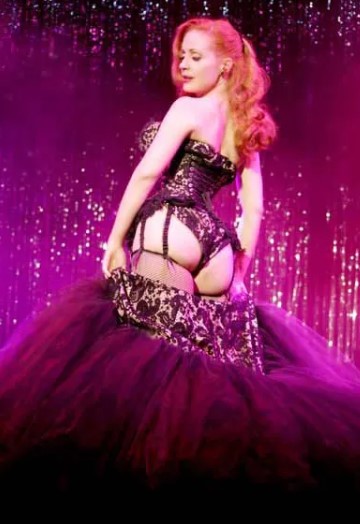There are a lot of implications behind feathers. From luxury to playfulness, it’s not surprising why burlesque extensively uses this material.
If you want to see it in action, look no further than the famous fan dance.
In fan dance performances, dancers – often in vibrant, glittery costumes – fluidly wave feathery fans of all colors, shapes, and sizes around the stage.
The fans draw the eyes of the audience as they fill up the space with their splendors.
In today’s article, we’ll dive deep into this exquisite dance form, from its history and techniques to famous dancers through the years!
Table of Contents
Fan Dance Definition
The definition of fan dancing is straightforward enough. In fact, all that you need to know is right within its name: it’s dancing with fans as props.
Fan dancing isn’t just the erotic-style dancing that you see in Western burlesque, though. This dance form is actually extremely old and exists in many nations’ cultures worldwide as traditional dance.
Even today, you can spectate many traditional fan dancing performances in Asian countries like China, Japan, South Korea, and Vietnam.
In South Korea, for example, fan dancing is known as “Buchaechum” and it has been around since the 1950s.
Fan Dance History
As we said earlier, the history of fan dancing is long and rich. It was first recorded appearing in China around the Han Dynasty in 200AD. That’s over a thousand years ago!
Besides being the era where Chinese culture and arts flourished, the Han Dynasty was the first Chinese dynasty to see the value in preserving culture and art.
Their forward-thinking is the reason why fan dancing is still around for us to enjoy and admire today.
In Ancient China, fan dancing is separated into two subtypes: civilian and military. The dance is most commonly performed in the civilian world.
Each movement of the dancer is fluid and graceful, not unlike ballet. The dancer will wield fans and other props like feathered banners to make the dance even more visually attractive.
The military-style “fan dancing” is a bit of a misnomer. Fans weren’t involved in the dance. Instead, the dancers appropriated moves from civilian-style fan dancing, making them more martial-like.
The purpose is to demonstrate the martial prowess of the military and to be a type of exercise for soldiers. Soldiers would dance with props occasionally.
But in place of fans, they would use weapons. Their moves would be more rigid and mighty.
As the Chinese propagated the dance throughout Asia, it was adopted by different countries. That’s why you will see variations of fan dancing in countries like Japan, South Korea, and Vietnam today.
In the modern age, fan dancing eventually made its way Westward. The western audience was instantly attracted by fan dancers’ graceful, almost sensual movements.
In the 1900s, fan dancing was incorporated into burlesque performances and grew in popularity.
Apparently, fan dancing was timeless, as it’s still around today. And there’s no sign that it will go away anytime soon.
Types Of Fan Dance
There are two distinct kinds of fan dance that are different in both look and feel.
So, check your ticket or event description carefully before you go to one. Otherwise, you will leave the venue feeling confused.
Traditional Dance
Traditional fan dancing is usually distinguished by their country of origin. There is Chinese traditional fan dancing called 扇子舞 (shànziwǔ). Korea also has its flavor of the fan dance 부채춤 (Buchaechum).
And suppose you were to visit Japan around the 14-15th of August. In that case, you may be able to participate in the Obon Festival, where the Bon Odori (盆踊り) is performed.
Fans aren’t the primary type of prop used in Bon Odori, but they are included.
Each type of dance is different in the move set and the costume, the fan, and even the meanings behind them.
Chinese fan dance performances are play-like. They have a plot behind them, typically a retelling of classic Chinese tales.
After all, fan dancing was created as a way for people to pass down stories through generations. This is why you’ll often see traditional fan dancing at cultural festivals.
It’s not just a kind of dance that looks good on the eye. It’s also a way for dancers to display their rich cultural roots.
Korean’s Buchaechum is less about stories and more about aesthetics.
It was created in 1954 by a Korean dancer named Kim Baek-bong to promote Korean national culture domestically and internationally. It’s still performed today.
Last but not least, the Bon Odori dance in Japan is performed to honor the spirits of the ancestors of the Japanese people.
Occasionally, dancers can use fans to beautify their performances further, but fans aren’t the show’s main star. Depending on the programming, you may not even see any fans during the festival!
Erotic Dance
In the west, fan dancing was transformed into a type of erotic dance. It’s usually performed by women, but you may find a few performances being given by male dancers, too.
The dancer on-stage will perform in sensual clothes that are a signature of burlesque performance. Or, in certain special events, they may perform entirely nude.
Burlesque fan dance started appearing around the 1900s and quickly grew popular among concert-goers.
It’s still very popular today and you can catch a fan dance set at virtually every club around the country.
Fan Dance Costume
Fan dances, both traditional and contemporary, are usually performed by costumed dancers.
In traditional-style fan dances, most dancers will wear the traditional clothing of the dance’s country of origin. For example, Korean fan dancers will most likely wear Hanbok.
In modern burlesque fan dance, the clothes will differ depending on the theme of the night. You will find costumes of various designs and colors. Dancers may even dance nude if it’s part of the programming.
The Fan
Of course, performance can’t be called a “fan dance” without the fans.
For traditional performances, the fans typically have a very simple design consisting of paper leaves and structured with thin wood ribs.
Extra décors can be added to give the fans some special visual effects, like jewels or feathers.
The fans used by burlesque dancers can be made from a variety of materials, ranging from feather, velvet, and silk to sequined and organza fabrics.
Spins and fan staves provide the form for the fans.
Famous Dancers
Considering how popular fan dancing has become over the years, it’s not surprising that there were many famous names associated with it.
Here are a few that you should know about.
Sally Rand
Sally Rand is a famous dancer in the burlesque industry. Born in 1904 in Elkton, Missouri as Helen Gould Beck, she’s arguably the person responsible for the enduring popularity of fan dancing in burlesque today.
Though she was famous for a variety of performances and stunts, one of her most memorable was her burlesque performances with fans made from ostrich feathers.
Sally’s career started with fan dancing. She performed it in the Paramount Club in Chicago. Some of the later highlights of her career were with fan dancing, too.
Notably, she was arrested four times in a day as she performed a fan dance routine on the back of a white horse down the street of Chicago.
The police arrested her because of “indecent exposure”, but later released her because the nude look was only an illusion made by the bodypaint.
Faith Bacon
Faith Bacon, born Frances Yvonne Bacon in 1910, was a legendary burlesque dancer on par with Sally Rand.
Her career took off in the 1920s when she went to Paris and took up a gig with Maurice Chevalier and his revue there.
Although she didn’t have any formal training in dancing at the time, she took to it like a fish to water.
Her performances included dancing nude with a variety of props, ranging from bubbles and flowers to, you guessed it, fans.
Her first appearance in the United States was titled “Fan Dance – Heart of the Daisies”. Fan dancing continued to be a part of her routine later down the line.
Famously, she used it to dodge indecent exposure laws at the time by using fans to hide her body, allowing her to skirt the laws.
Faith considered herself the “original fan dancer”, a title that a great many other artists had laid claim to over the years.
Dita Von Teese
Dita Von Teese (born Heather Rénee Sweet) is considered by many to be the modern-day Sally Rand. And not without a reason!
She’s famous for her fan dance performances, which she admitted took a lot of inspiration from the classic performances of Sally Rand.
The fans that she used during her performances were also large, feathery fans.
But that doesn’t mean her performances were carbon copies of Sally’s. Von Teese put her own twists into each performance, making every show a pleasure to watch!
Catherine D’Lish
Catherine D’Lish is an American burlesque dancer that’s also known for her fan dance performances.
She’s a friend of Dita Von Teese and the two had performed together on stage on many occasions.
D’Lish was a recognizable face in the industry, having performed at the 50th anniversary of Playboy magazine and numerous high-profile shows around Vegas.
Movies About Fan Dance
Gypsy
Gypsy, released in 1962 and directed by Mervyn Leroy, is an American musical comedy-drama movie. The movie was based on a book by Arthur Laurents called “Gypsy: A Musical Fable”.
The book itself was adapted from the autobiography of Gypsy Rose Lee, a famous burlesque dancer.
It follows the story of Rose, a domineering and aggressive woman with two daughters, June and Louise.
Rose is determined to push her daughters to stardom with the aid of a talent agent named Herbie Sommers, who was in love with her.
It’s a classic movie with excellent ratings. And the many fan dance scenes are beautifully choreographed. It’s well worth a watch if you want to see fan dancing on the big screen!
The Right Stuff
The Right Stuff is a historical movie released in 1983. The premise has nothing to do with fan dancing.
It’s actually a movie about the Cold War-era space program and how it progressed from the first man to break the sound barrier (Chuck Yeager) to the Mercury 7 mission that put the first men in orbit.
Within the movie, though, there’s a fan dancing scene, which looks pretty splendid and well-choreographed.
Once again, it’s worth a look if you have nothing else to watch on the weekends!
Fan Dance Music
The music will depend on the type of fan dance you’re watching as well as the theme.
In traditional fan dance performances, the music is usually folk music of the originating country.
In burlesque shows, the music can either be classical (like Sally Rand’s performance over Debussy’s Clair de Lune) or something more upbeat and modern, like jazz and electronic music.
Final Words
Fan dance is a fantastic dance form that can be enjoyed by history buffs and burlesque enjoyers alike!
Though it’s mostly known in the west as a suggestive dance form, as you can see, it actually has a long, rich history.
Find a show near you and give it a shot. You definitely won’t regret it after seeing the fluid, mesmerizing motions of the dancers and their fans.
